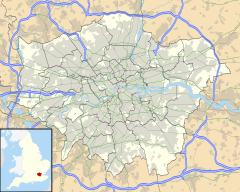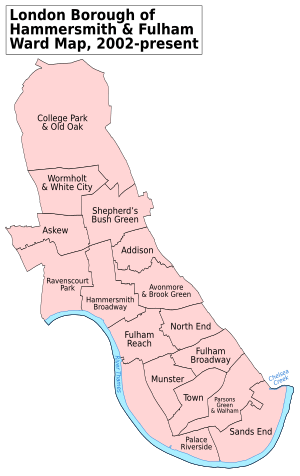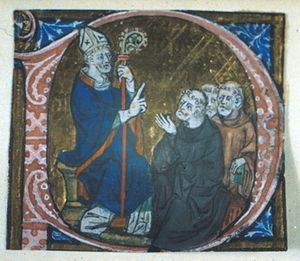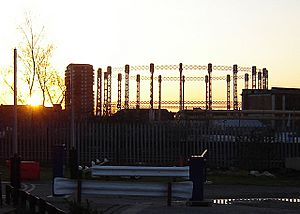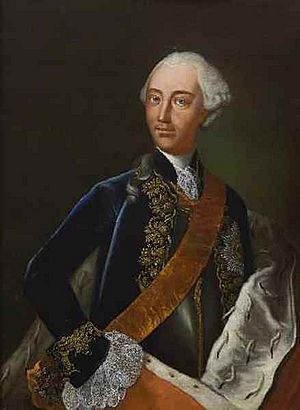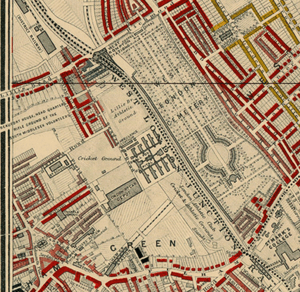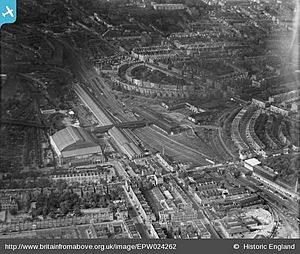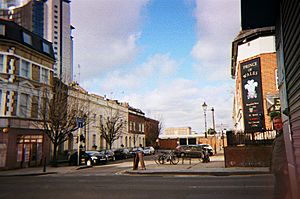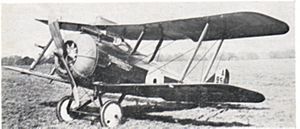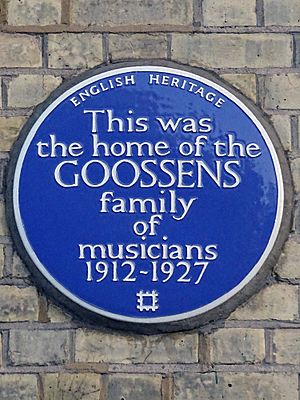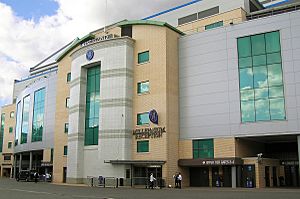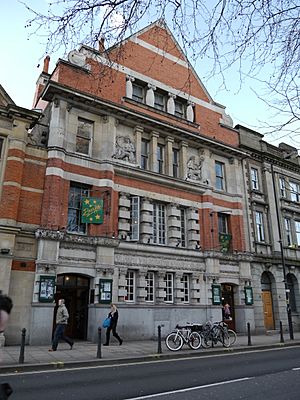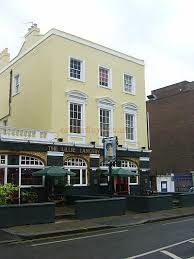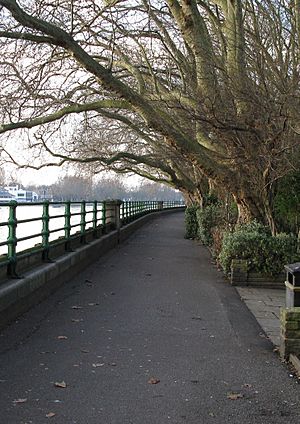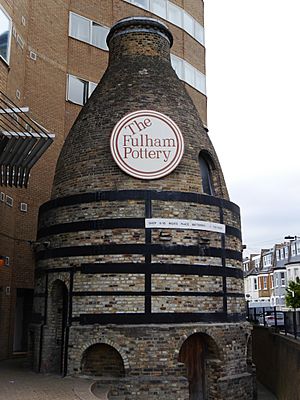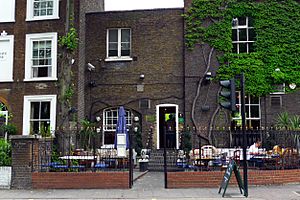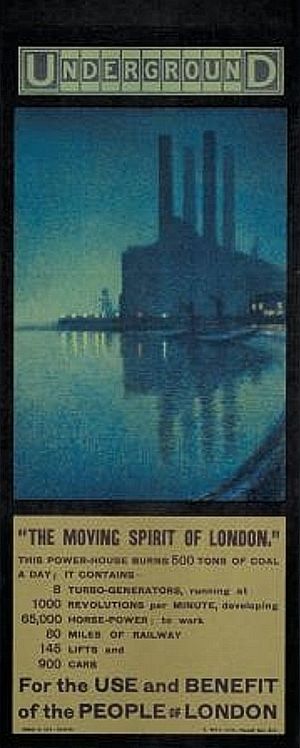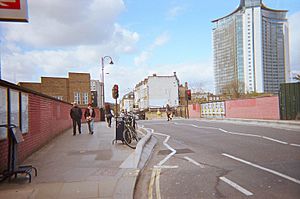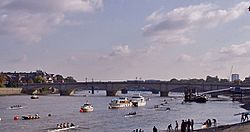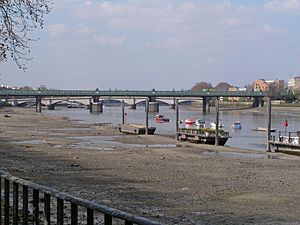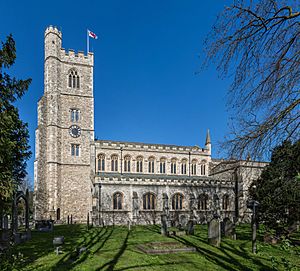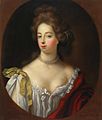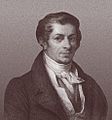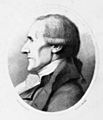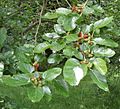Fulham facts for kids
Quick facts for kids Fulham |
|
|---|---|
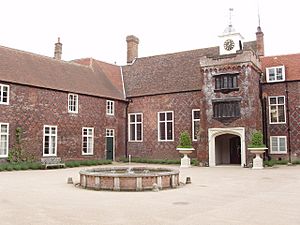 Fulham Palace, the former residence of the Bishop of London |
|
| Population | 87,161 (2011) |
| OS grid reference | TQ245765 |
| • Charing Cross | 3.6 mi (5.8 km) NE |
| Ceremonial county | Greater London |
| Region | |
| Country | England |
| Sovereign state | United Kingdom |
| Post town | LONDON |
| Postcode district | SW6, W14, W6 |
| Dialling code | 020 |
| Police | Metropolitan |
| Fire | London |
| Ambulance | London |
| EU Parliament | London |
| UK Parliament |
|
Fulham is an area of the London Borough of Hammersmith & Fulham in West London, England, 3.6 miles (5.8 km) southwest of Charing Cross. It lies on the north bank of the River Thames, bordering Hammersmith, Kensington and Chelsea. The area faces Wandsworth, Putney, Barn Elms and the London Wetland Centre in Barnes. on the far side of the river.
First recorded by name in 691, Fulham was a manor and ancient parish which originally included Hammersmith. Between 1900 and 1965, it was the Metropolitan Borough of Fulham, before its merger with the Metropolitan Borough of Hammersmith created the London Borough of Hammersmith and Fulham. The district is split between the western and south-western postal areas.
Fulham has a history of industry and enterprise dating back to the 15th century, with pottery, tapestry-weaving, paper-making and brewing in the 17th and 18th centuries in present-day Fulham High Street, and later involvement in the automotive industry, early aviation, food production, and laundries. In the 19th-century there was glass-blowing and this resurged in the 21st century with the Aronson-Noon studio and the former Zest gallery in Rickett Street. Lillie Bridge Depot, a railway engineering depot opened in 1872, is associated with the building and extension of the London Underground, the electrification of Tube lines from the nearby Lots Road Power Station, and for well over a century has been the maintenance hub for rolling stock and track.
Two football clubs, Fulham and Chelsea, play in Fulham. Two other notable sporting clubs are the Hurlingham Club, known for polo, and the Queen's tennis club, known for its annual pre-Wimbledon tennis tournament. In the 1800s, Lillie Bridge Grounds hosted the first meetings of the Amateur Athletic Association of England, the second FA Cup Final, and the first amateur boxing matches. The Lillie Bridge area was the home ground of the Middlesex County Cricket Club, before it moved to Marylebone.
Contents
History
Fulham Palace - the Manor of Fulham
Fulham, or in its earliest form "Fulanhamme", is thought to have signified the place either "place of fowls" or "of mud" (which probably had to do with the fact that the River Thames would flood it periodically), or alternatively, "land in the crook of a river bend belonging to an Anglo Saxon chief named Fulla". The manor of Fulham is said to have been given to Bishop Erkenwald about the year 691 for himself and his successors in the See of London. In effect, Fulham Palace, for nine centuries the summer residence of the Bishops of London, is the manor of Fulham. In 879 Danish invaders, sailed up the Thames and wintered at Fulham and Hammersmith. Raphael Holinshed relates that the Bishop of London was lodging in his manor place in 1141 when Geoffrey de Mandeville, riding out from the Tower of London, took him prisoner. During the Commonwealth the manor was temporarily out of the bishops' hands, having been sold to Colonel Edmund Harvey.
In recent years there has been a great revival of interest in Fulham's earliest history, due almost entirely to the efforts of the Fulham Archaeological Rescue Group. This has carried out a number of interesting digs, particularly in the vicinity of Fulham Palace, which show that approximately 5,000 years ago Neolithic people were living by the riverside and in other parts of the area. Excavations have also revealed Roman settlements during the third and fourth centuries AD.
Fulham parish
There is no record of the original erection of a Parish church in Fulham, but the first written record of a church dates from 1154 as a result of a tithe dispute. The first known parish priest of All Saints Church, Fulham was appointed in 1242. The medieval extant part of All Saints Church was demolished in 1881, during reconstruction by Sir Arthur Blomfield, in order to enlarge it, however, it did not date farther back than the 15th century. Interestingly, there is a comparably old church on the opposite bank of the Thames, St Mary's Church, Putney, on the other side of the river crossing.
In 1642 the Earl of Essex threw a bridge of boats across the river in order to march his army in pursuit of Charles I, who thereupon fell back on Oxford. This is thought to have been near the subsequent wooden Fulham Bridge, built in 1729 and replaced in 1886 with Putney Bridge. Margravine Road recalls the existence of Brandenburg House, a riverside mansion built by Sir Nicholas Crispe in the time of Charles I, and used as the headquarters of General Fairfax in 1647 during the civil wars. In 1792 it was occupied by Charles Alexander, Margrave of Brandenburg-Ansbach and his wife, and in 1820 by Caroline, consort of George IV. His non-political 'wife' was Maria Fitzherbert who lived in East End House in Parson's Green. They are reputed to have had several children.
Until 1834, the neighbouring village of Hammersmith had been incorporated in the parish of Fulham. However, due to population expansion, it was decided to create separate parishes for the purposes of administration. They did not come together again until 1965.
19th-century transport and power plays
The 19th-century roused Walham Green village, and the surrounding hamlets that made up the parish of Fulham, from their rural slumber and market gardens with the advent first of power production and then more hesitant transport development. This was accompanied by accelerating urbanisation, as in other centres in the county of Middlesex, which encouraged trade skills among the growing population. In 1824 the Imperial Gas Light and Coke Company, the first public utility company in the world, bought the Sandford estate in Sands End to produce gas for lighting - and in the case of the Hurlingham Club, for ballooning. Its ornately decorated number 2 gasholder is Georgian, completed in 1830 and reputed to be the oldest gasholder in the World. In connection with gas property portfolios, in 1843 the newly formed Westminster Cemetery Company had trouble persuading the Equitable gas people (a future Imperial take-over) to sell them a small portion of land to gain southern access, onto the Fulham Road, from their recently laid out Brompton Cemetery, over the parish border in Chelsea. The sale was finally achieved through the intervention of cemetery shareholder and Fulham resident, John Gunter.
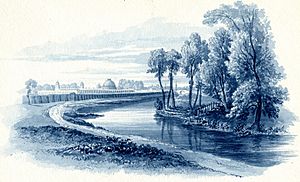
Meanwhile, another group of local landowners, led by Lord Kensington with Sir John Scott Lillie and others had conceived, in 1822, the idea of exploiting the water course up-river from Chelsea Creek on their land by turning it into a two-mile canal. It was to have a basin, a lock and wharves, to be known as the Kensington Canal, and link the Grand Union Canal with the Thames. In practice the project was over budget and delayed by contractor bankruptcies and only opened in 1828, when railways were already gaining traction. The short-lived canal concept did however leave a legacy: the creation on Lillie's land of a brewery and residential development, 'Rosa' - and 'Hermitage Cottages', and several roads, notably, the Lillie Road connecting the canal bridge, (Lillie Bridge) at West Brompton with North End Lane and the eventual creation of two railway lines, the West London Line and the District line connecting South London with the rest of the capital. This was done with the input of two noted consulting engineers, Robert Stephenson in 1840 and from 1860, Sir John Fowler.
It meant also that the area around Lillie Bridge was to make a lasting, if largely unsung, contribution for well over a century to the development and maintenance of public transport in London and beyond. Next to the Lillie Bridge engineering Depot, the Midland Railway established its own coal and goods yard. In !907 the engineering HQ of the Piccadilly Line in Richmond Place (16-18 Empress Place) oversaw the westward expansion of the line into the suburbs. At the turn of the century, the London Omnibus Co. in Seagrave Road oversaw the transition of horse-drawn to motor buses, which were eventually integrated into London Transport and London Buses. This attracted a host of other automotive enterprises to move into the area.
With the growth of 19th-century transport links into East Fulham and its sporting venues by 'Lillie Bridge', along with the immediately neighbouring 24-acre Earl's Court exhibition grounds, and the vast the Empress Hall (see entertainment section below). During the First World War it would become accommodation for Belgian refugees. Meanwhile, the historic hamlet of North End was massively redeveloped in the 1880s by Messrs Gibbs & Flew, who built 1,200 houses on the fields. They had trouble disposing of the properties, so for public relations purposes, they renamed the area 'West Kensington', to refer to the more prosperous neighbourhood over the parish boundary.
The last farm to function in Fulham was Crabtree Farm, which closed at the beginning of the 20th-century. A principal recorder of all these changes was a local man, Charles James Féret (1854-1921), who conducted research over a period of decades before publishing his three volume history of Fulham in 1900.
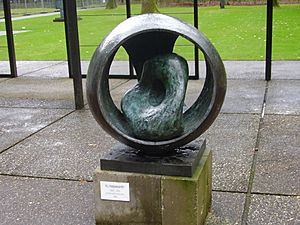
Art and Craft
Ceramics and weaving in Fulham go back to at least the 17th-century, most notably with the Fulham Pottery, followed by the establishment of tapestry and carpet production with a branch of the French 'Gobelins manufactory' and then the short-lived Parisot weaving school venture in the 1750s. William De Morgan, ceramicist and novelist, moved into Sands End with his painter wife, Evelyn De Morgan, where they lived and worked. Another artist couple, also members of the Arts and Crafts movement, lived at 'The Grange' in North End, Georgiana Burne-Jones and her husband, Edward Burne-Jones, both couples were friends of William Morris. Other artists who settled along the Lillie Road, were Francesco Bartolozzi, a florentine engraver, and Benjamin Rawlinson Faulkner, a society portrait painter. Henri Gaudier-Brzeska, the French expressionist painter and friend of Ezra Pound, lived in Walham Green till his early death in 1915. Glass production was, until recently, represented by the Stained glass studio of the purpose-built and Grade II listed Glass House in Lettice Street and latterly, by the Aaronson Noon Studio, with the 'Zest' Gallery in Rickett Street, that was obliged to shut down in 2012, after 20 years by the developers of 'Lillie Square' and Earl's Court. Both glass businesses have now moved out of London. The Art Bronze Foundry, founded by Charles Gaskin in 1922 still operates in Michael Road, off the New King's Road, a short distance from Eel Brook Common. It has produced works by Henry Moore, Elisabeth Frink, Barbara Hepworth and Jacob Epstein among others. Its work may be seen in public spaces all over the world.
20th-century
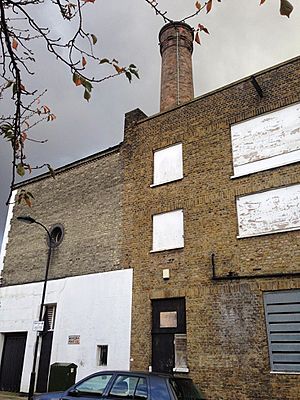
Fulham remained a predominantly working class area for the first half of the twentieth century, with genteel pockets at North End, along the top of Lillie Road and New King's Road, especially around Parsons Green, Eel Brook Common, South Park and the area surrounding the Hurlingham Club. Essentially, the area had attracted waves of immigrants from the countryside to service industrialisation and the more privileged parts of the capital. With rapid demographic changes there was poverty, as had been noted by Charles Dickens and Charles Booth and Fulham had its Poorhouses, and attracted several benefactors, including: the Samuel Lewis (financier) Housing Trust, the Peabody Trust and Sir Oswald Stoll Foundation to provide low-cost housing. The Metropolitan Asylums Board acquired in 1876 a 13-acre site at the bottom of Seagrave Road, to build a fever hospital, 'The Western Hospital', that later became an NHS centre of excellence for treating polio until its final closure in 1979. Bar one ward block remaining in private occupation, it was replaced by a gated flats development and a small public space, Brompton Park.
Aside from the centuries-old brewing industry, e.g. The Swan Brewery on the Thames, the main activities were motor and early aviation- Rolls Royce, Shell-Mex, Rover, the London Omnibus Co. - and rail engineering (Lillie Bridge Depot), laundries - the Palace Laundry is still extant - and the building trades. Later there was distilling, Sir Robert Burnett's White Satin Gin, food processing, e.g. Telfer's Pies, Encafood and Spaghetti House and Kodak's photographic processing. This encouraged the southern stretch of North End Road to become Fulham's unofficial 'High street', almost a mile from the actual Fulham High Street, with its own department store, F.H. Barbers, along with Woolworth's, Marks & Spencer and Sainsbury's outlets, all long gone. The second ever Tesco shop opened in the North End Road. The UK's reputedly oldest independent health food shop, opened in 1966 by the Aetherius Society, still trades in the Fulham Road.
Allied to these developments, the post-war period saw the extensive demolition of Fulham's early 19th-century architectural stock, replaced by some Brutalist architecture - the current Ibis hotel - and the Empress State Building in Lillie Road that in 1962 replaced the declining Empress Hall. The LCC and local council continued with much needed social housing development between the Second World War and up to the 1980s.
A piece of aviation history
Geoffrey de Havilland, aviation pioneer, built his first aeroplane at his workshop in Bothwell Street, Fulham in 1909. Later, during World War I, Cannon's Brewery site at the corner of Lillie and North End Road was used for aircraft manufacture. The Darracq Motor Engineering Company of Townmead Road, became aircraft manufacturers in Fulham for the Airco company, producing De Havilland designs and components for the duration of the war.
Musical heritage
William Crathern, the composer, was organist at St Mary's church, West Kensington, when it was still known as North End. Edward Elgar, the composer, lived at 51 Avonmore Road, W14, between 1890–1891. Eugène Goossens and his wife Annie Cook, a Carl Rosa Opera Company singer settled in Fulham with their family. They were part of a musical dynasty of Belgian descent. Their eldest son was the conductor and composer Sir Eugene Aynsley Goossens next was Léon Jean Goossens (1897-1988), a British oboist, their daughters were the harpists, Marie and Sidonie Goossens. The family lived at 70, Edith Road, off the North End Road. Elvis Costello spent part of his youth in the area as he recalls in his Memoir.
21st-century 'Gentrification'
In the 21st-century, Fulham is rated as one of the most expensive parts of London, and therefore the UK; average actual sale price of all property (both houses and flats) sold in the SW6 area in September 2007 was £639,973. There are renewed plans to forcibly displace the residents of social housing, some of whom are immigrants and demolish large numbers of the small enterprises, some of them run by people of ethnic minorities, for which Fulham has been famous and replace them with dense high-rise luxury blocks and the ubiquitous high street chains.
Redevelopment
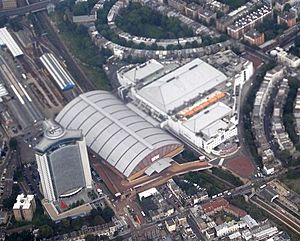
With the accession of Boris Johnson to the mayoralty of London, a controversial 80 acre high-rise redevelopment has been under way on the eastern borough boundary with the Royal Borough of Kensington and Chelsea, involving the dismantling of the two Earls Court Exhibition Centres in RBKC and in Hammersmith and Fulham and the emptying and demolition of hundreds of commercial properties, thousands of both private and social housing units and including the demolition of a rare example in Fulham of mid-Victorian housing, designed by John Young (architect), close to Grade I and II listed structures and to a number of conservation areas in both boroughs. It also involves the closure of the historic Lillie Bridge Depot, opened in 1872 and the dispersal of its operations by TfL
Namesake
The latest edition (2008) of the Chambers Dictionary defines a fulham as 'a die loaded at the corner to ensure that certain numbers are thrown (also full'am or full'an). Prob the place name 'Fulham' in London.' The OED distinguishes between a high fulham which was loaded so as to ensure a cast of 4, 5, or 6; and a low fulham, so as to ensure a cast of 1, 2, or 3). It also cites Arthur Conan Doyle's usage in 1889 in Micah Clarke xxx. 316 "There is no loading of the dice, or throwing of fulhams."
Sport, entertainment and life-style
Sport
Before the area became home to the Fulham FC stadium Craven Cottage and the Chelsea FC stadium Stamford Bridge (and the various flats and entertainment centres built into it), the Lillie Bridge Grounds was the venue where British Amateur Athletics were born and the first codified Boxing under Marquess of Queensberry Rules took place. All this was accomplished through the catalyst that was John Graham Chambers from the mid-1860s.
Famously exclusive sports clubs, the Queen's Club for tennis and the Hurlingham Club, are located within Fulham.
In the case of the latter, members have included British monarchs and the waiting list for membership currently averages over fifteen years. Public tennis courts are located at the entrance to Fulham Palace. Tennis courts can also be found on Eel Brook Common. Hurlingham Park's tennis courts are used as netball courts and tennis nets are taken down and so restricting access to the courts for tennis. Hurlingham Park hosts the annual Polo in the Park tournament, which has become a recent feature of the area. The Hurlingham club is the historic home of polo in the United Kingdom and of the world governing body of polo.
Rugby is played on Eel Brook Common and South Park. Normand Park in Lillie Road is the entry into the Virgin Active-operated Fulham Pools swimming facilities and neighbouring tennis courts. Fulham can boast of two connections with the 'royal' game of Real tennis. There are the courts at the Queen's Club and then there was an unsurpassed designer of real tennis courts, one Joseph Bickley (1835-1923), who lived in Lillie Road and who took out a patent on his plaster mixture that withstood condensation and damp. To Bickley's skill are owed the survival, among others, of courts at Hampton Court Palace, Jesmond Dene, at Troon in Ayrshire as well as at the local Queen's.
Fulham has five active Bowls clubs: The Bishops Park Bowls club, The Hurlingham Park Bowls Club, Normand Park Bowls Club, The Parson's Green Bowls club and The Winnington in Bishops Park.
Entertainment
The most considerable entertainment (and sports) destinations in Fulham, after the Lillie Bridge Grounds closed in 1888, have been the 6,000-seater Empress Hall, built in 1894 at the instigation of international impresario, Imre Kiralfy — the scene of his spectacular shows and later sporting events and famous ice shows — and latterly, Earl's Court II, part of the Earl's Court Exhibition Centre in the neighbouring, Royal Borough of Kensington and Chelsea. The first closed in 1959, replaced by an office block, the Empress State Building. The second, opened by Princess Diana, lasted just over 20 years until 2014. Along with the architecturally pleasing Mid-Victorian Empress Place, formerly access to the exhibition centre, it is destined for high rise re-development, but with usage as yet to be confirmed.
No trace is left today of either of Fulham's two theatres, both opened in 1897. The 'Grand Theatre' was on the approach to Putney Bridge and was designed by the prolific WGR Sprague, author of venues such as Wyndham's Theatre and the Aldwych Theatre in London's West End. It gave way to office blocks in the late 1950s. The 'Granville Theatre', founded by Dan Leno, to the design of Frank Matcham, once graced a triangle of land at Walham Green. After the Music hall era had passed, It served as a film and television studio, but was finally demolished in 1971. It too has been replaced by an office block in Fulham Broadway.
If traditional or heritage venues have been swept away — apparently during conservative administrations in the main — the performing arts continue in Fulham, like the notable Fulham Symphony Orchestra and the successful Fulham Opera. St John's Parish Church, at the top of North End Road, stages choral and instrumental concerts as do other churches in the area.
There is a cinema complex as part of the Fulham Broadway Centre. Fulham Town Hall, built in 1888 in the classical renaissance, is now used as a popular venue for concerts and dances, especially its Grand Hall. Behind Fulham Broadway, the heart of the original village of Walham Green has undergone pedestrianization, including the spot once occupied by the village green and its pond next to St. John's Parish Church and bordered by a number of cafés, bars, and a dance studio in the old Fulham Public Baths. The largest supermarket in Fulham, is located on the site of a cinema later converted to the iconic "Dicky Dirts" jean store with its sloping shop-floor, at the top of North End Road's Street market. It started a new trend in how retail was done.
Gin, breweries and pubs
The most illustrious brewery in Fulham was the Swan Brewery, Walham Green, dating back to the 17th century. Among its patrons were kings and other royalty. It was followed by the North End Brewery in 1832, Cannons again in North End in 1867 and finally on account of temperance, the alcohol-free phenomenon that was Kops Brewery founded in 1890 at a site in Sands End. In 1917 Kops Brewery closed and was converted into a margarine factory.
Gin distilling came to the remnants of the North End Brewery in Seagrave Road after a brief period of service as a timber works in the 1870s and lasted for almost a century. The premises were taken over by distillers Vickers who at the outbreak of the First World War sold out to Burnett's, producers of White Satin Gin, until a 1970s take-over by a Kentucky liquor business. None of the breweries remains.
With its long history of brewing, Fulham still has a number of pubs and gastropubs. The oldest tavern is the Lillie Langtry in Lillie Road, originally the Lillie Arms named after its first freeholder, Sir John Scott Lillie, who built it in 1835 as part of the 'North End Brewery' complex, run from 1832 to 1833 by a Miss Goslin. It was intended originally to service the Kensington Canal workers and bargees. Later, it was the watering hole of the new railway builders, motor and omnibus company staff and latterly Earl's Court exhibition and Chelsea F.C. visitors. Of the three popular neighbouring pubs acquired by developers during 2014–15, the Imperial Arms and the Prince of Wales were forced to shut; only the Atlas, reconstructed after bomb damage in the Second World War, has been reprieved.
The White Horse in Parsons Green is colloquially known by many as the "Sloaney Pony", a reference to the "Sloane Rangers" who frequent it. Pubs which are Grade II listed buildings include the Duke on the Green and Aragon House both facing Parsons Green, the Cock in North End Road, and the Temperance in Fulham High Street. Other pubs include the Durrell in Fulham Road, the locally and Michelin Guide listed 1866 Harwood Arms in Walham Grove and the Mitre on Bishops Road.
Open space
Fulham has several parks, cemeteries and open spaces, of which Bishop's Park, Fulham Palace Gardens, Hurlingham Park, South Park, Eel Brook Common and Parsons Green are the largest.
Among the other spaces are Normand Park, the vestige of a convent garden with a bowling green, Lillie Road Recreation Ground with its gym facility and Brompton Park in Seagrave Road. The Thames riverside walk in Bishop's Park is interrupted by the Fulham football ground, but resumes after the neighbouring flats and continues to the Crabtree pub and beyond, past the Riverside Cafe on towards Hammersmith Bridge, affording views of the river and rural scenes on the opposite bank. It is part of the Thames Path.
Heritage
Architectural
Fulham parish's rural past meant that its grand houses and not so grand vernacular and industrial buildings were either clustered in the village of Walham Green, along the Thames or scattered among the fields of the hamlet of North End. Many historic structures fell prey to industrialisation, war-time bombing or a rush to demolition and redevelopment. Gone are Burne-Jones's 'Grange' in W14 and Foote's 'Hermitage' villa and park as is Lovibond's Cannon Brewery in SW6. However, the ancient estate of Fulham Palace, the seat of the Bishops of London, remains the outstanding asset with its medieval and Tudor features, remnants of the grounds, now divided between public allotments and a park with a Kitchen garden and the part-excavated longest moat in England. Part of the buildings are Grade I listed, while others Grade II*. There are a number of other statutorily and locally listed structures strewn across Fulham. Worthy of note is the last remaining conical kiln of the Fulham Pottery. Broomhouse Lane has a number of structures of interest, ranging from the Broomhouse draw-dock of medieval origin to 18th-c. cottages (Sycamore and Ivy) and the Gothic revival Castle Club. The Vineyard in Hurlingham Road is of 17th-c. origin with later 19th-c. additions such as the stable buildings. The Hurlingham Club and grounds are of 18th-c. origin and Grade II* listed. The winding North End Road has several buildings of note, especially, 'Crowthers' at no. 282, first built in 1712 with its extant 18th-c. gate-piers and the modernist (1938) Seven Stars public house, now converted into flats. Church Gate is the approach to All Saints Church, with its 14-15th-c. tower and 18th-c. tombs in the churchyard. The New King's Road contains several 18th-c. and early 19th-c. residences, namely, Northumberland House, Claybrook House, Jasmine House, Belgrave House and Aragon House, all Grade II listed.
Much of the stock in Fulham attests its vigorous 19th-c. industrial and urban development, most of it, 'low-rise', and benefiting from the brick-fields that abounded locally at the time. An unlisted vestige of the early industrial era is the 1826 remnant of Gunter's canal bridge, still visible from platform 4 at West Brompton station.
Fulham in popular music and film
Fulham has several references in song lyrics. Willesden Green by The Kinks opens with the line: Well I tried to settle down Fulham Broadway.
The album, Passion Play, by progressive rock band, Jethro Tull, contains: There was a rush along the Fulham Road/There was a hush in the Passion Play. London's Brilliant Parade by Elvis Costello, has the lyrics, From the gates of St. Mary's/There were horses in Olympia/And a trolley bus in Fulham Broadway.
What A Waste by Ian Dury and the Blockheads, contains the lines: I could be a writer with a growing reputation/I could be a ticket man at Fulham Broadway Station.
Kiss Me Deadly by Billy Idol's 1970s punk rock band, Generation X, paints a gritty picture of casual street violence in 1970s Fulham. The song contains the refrain: Having fun, in South West Six, as well as the line, Hustling down the Fulham Road/Doing deals with Mr Cool. The song also makes reference to The Greyhound Pub, since closed, on Fulham Palace Road, and to the subway under Hammersmith Broadway.
West London Punk band, The Lurkers, titled their 1978 début LP, Fulham Fallout.
Maladjusted by Morrissey, former singer of The Smiths, contains the lines: As the Fulham Road lights/Stretch and invite into the night/From a Stevenage overspill/We'd kill to live around SW6. 'Stevenage overspill' is a reference to Fulham F.C. crowds as the club's ground, Craven Cottage is situated on Stevenage Road.
Ejector Seat Reservation by alternative rock band, Swervedriver, has the line: And just don't tell me the Fulham score.
Reformed boy band, Take That, sang the line: At Fulham Broadway Station, I see them every day in their song, Pretty Things, on their 2010 Progress, album.
West London hip-hop artist, Example, released a comedy song, You Can't Rap, with the chorus line: You can't rap, my friend/You're white and you're from Fulham/Please put down the mic./ There's no way you can fool them.
Fulham has appeared in a number of films, including The Omen and The L-Shaped Room. Fulham Broadway tube station was used in Sliding Doors. Esther Rantzen, presenter of the long-running BBC One TV magazine programme, That's Life!, often conducted vox pop interviews in North End market.
Education
Fulham is home to several schools, including independent pre-preparatory and preparatory schools. Noted Fulham secondary establishments are the Grade II Listed Fulham Cross Girls School, The Oratory School, Lady Margaret School and Henry Compton School. To cater for the large French-speaking population in the area, a French language primary school, 'Marie d'Orliac', has opened near Putney Bridge station. It is a feeder school for the Lycée Français Charles de Gaulle in South Kensington.
Interior design destinations
Fulham's artistic and craft heritage continues in the guise of groups of specialist retail outlets in several locations, such as the Wandsworth Bridge and Carnwarth Roads. The corner of Lillie Road and Munster Road hosts a number of antique shops. New Kings Road has a number of interior shops and galleries, particularly near Lots Road and as it merges with Kings Road, Chelsea, and goes through Parsons Green. Chelsea Harbour is a favoured destination for interior designers.
Transport
An early account of Fulham, from a pedestrian's viewpoint, is provided by Thomas Crofton Croker in his journal published in 1860.
Rail
Fulham nestles in a loop of the Thames across the river from Barnes and Putney. It straddles the Wimbledon and Richmond/Ealing Broadway branches of the District line of the tube — Fulham's tube stations are Putney Bridge, Parsons Green, Fulham Broadway (originally named Walham Green), West Kensington (originally Fulham - North End) and Baron's Court.
The London Overground West London Line stops at West Brompton, just inside the Fulham borough boundary, and at Imperial Wharf in Fulham, Sands End. Until 1940 there was a Chelsea and Fulham railway station on this line, close to Stamford Bridge Stadium on Fulham Road, but this was closed following World War II bomb damage.
Major roads
Major urban routes, or trunk roads, cross the area: The Talgarth Road — the A4, Fulham Palace Road — the A218 road, Fulham Road — the A219 road, the New King's Road — the A308 road, Wandsworth Bridge Road — the A217 road, Dawes Road — the A3219 road, Lillie Road — the A3218 road.
River crossings
By road:
- Wandsworth Bridge
- Putney Bridge
- Lillie Bridge, formerly a Thames tributary crossing, now over two railway routes.
- Counter's Bridge at Olympia, over the West London Line in the Counter's creek littoral.
By rail:
- Cremorne Bridge
- Fulham Railway Bridge
Places of interest
- Fulham Palace
- Fulham Pottery
- Margravine Cemetery
- Bishops Park
- Chelsea Harbour
- Stamford Bridge (stadium)
- All Saints Church, Fulham
- Craven Cottage
- New King's Road
- Riverside Studios, currently closed for refurbishment
- South Park, Fulham
John Roque's 1746 Map
The extract below of John Rocque's Map of London, 1746 shows the Parish of Fulham in the loop of the Thames, with Counter's Creek distinctly visible to the left, just below the 'elbow' in the river.
| B | ||
|---|---|---|
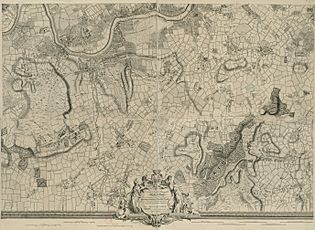 |
2 | |
| This sheet extract is a clickable image for enlargement | ||
Notable residents
- Sir William Butts (1486–1545), physician to King Henry VIII of England
- Sir Ralph Warren (c. 1486–1553). twice Lord Mayor of London lived in Fulham House
- Joseph Addison (1672–1719), essayist, playwright lived at Sands End
- Henry Compton (1632–1713), Bishop of London
- Nell Gwyn (1650–1687), companion to Charles II of England, has a close named after her in Fulham
- Humphrey Henchman (1592–1675), Bishop of London
- John Mordaunt, 1st Viscount Mordaunt (1626–1675), royalist conspirator prominent in the English Civil War
- John Robinson, Bishop of London
- John Saris (1580–1643), captain of the first English ship to reach Japan
- Sir William Withers (1657–1720), Lord Mayor of London
- Francesco Bartolozzi (1725–1815), Italian engraver
- Maria Fitzherbert (1756–1837), companion, and possibly wife, of King George IV
- Samuel Foote (1721–1777), dramatist, actor and manager
- Edmund Gibson (1669–1748), Bishop of London
- Thomas Hayter (1702–1762), Bishop of London
- Theodore Hook (1788–1841), creator of the world's first postcard.
- Nathaniel Kent (1737–1810), agriculturist
- Emlyn Williams (1905–1987), actor, dramatist, author, lived at 15 Pelham Crescent from 1937 to 1962
- Robert Lowth (1710–1787), Bishop of London
- Henry Holland (1745–1806), architect
- Samuel Richardson (1689–1761), writer and printer
- Jean-Baptiste Say (1767–1832), French liberal economist known for Say's law on the behaviour of markets
- Granville Sharp (1735–1813), abolitionist and brother of William
- William Sharp (1729–1810), surgeon
- Thomas Sherlock (1678–1761), Bishop of London
- Richard Terrick (1710–1777), Bishop of London
- Joseph Bickley (1835–1923), Lillie Road-based Real tennis court designer and restorer
- Arthur Blomfield (1829–1899), architect
- Charles James Blomfield (1786–1857), Bishop of London
- William John Burchell (1781–1863), explorer, naturalist, artist, and author
- Edward Burne-Jones (1833–1898), artist
- Georgiana Burne-Jones (1840–1920), painter and writer, friend of George Eliot
- Mandell Creighton (1843–1901), historian and Bishop of London; a popular social centre in Lillie Road is named after him.
- Evelyn De Morgan (1855–1919), painter in the Pre-Raphaelite tradition
- William De Morgan (1832–1917), potter, ceramicist, designer and novelist
- Benjamin Rawlinson Faulkner (1787–1849), society portrait painter, lived in Richmond (Lillie) Road
- Charles James Féret (1854–1921), editor and historian of Fulham
- Alfred Hackman (1811–1874), sub-librarian at the Bodleian Library
- William Hurlstone (1876–1906), composer mostly of chamber music, born in Empress Place (formerly Richmond Gardens)
- John Jackson (1811–1885), Bishop of London
- Sir John Scott Lillie (1790–1868), Peninsular War veteran, inventor and North End resident
- Augustus Pugin (1812–1852), architect of St Thomas of Canterbury Church, Rylston Road
- Charles Rolls (1877–1910), co-founder of Rolls Royce Limited and pioneer aviator, had his car showroom in the former Lillie Hall
- John Young (1797–1877) City architect and developer of Empress Place and Lillie Road.
- Henri Gaudier-Brzeska (1891–1915), expressionist sculptor and artist spent the last 5 years of his short life in Fulham
- Linford Christie (born 1960), Olympian athlete
- Michael Cook (born 1933), Canadian playwright
- Jill Craigie (1911–1999), documentary film maker and wife of Michael Foot
- Example (Elliot John Gleave) (born 1982), rapper, singer, and songwriter
- Geoffrey de Havilland (1882–1965), aviation pioneer, had his first aircraft building workshop in Fulham
- Geoffrey Fisher (1887–1972), Bishop of London, then translated to the See of Canterbury
- Eugène Goossens, fils (1867–1958), musician and his four musical children: Sir Eugene Aynsley Goossens, Léon Jean Goossens, Marie and Sidonie Goossens
- Toni Halliday (born 1964), musician
- Andy Hamilton (born 1954), satirist, comic actor, writer and broadcaster
- Henry Montgomery Campbell (1887–1970), Bishop of London
- John Osborne (1929–1994), playwright
- Baroness Phillips (1910–1992), Labour politician, radio personality, wife of Morgan Phillips and mother of Gwyneth Dunwoody
- Daniel Radcliffe (born 1989), actor
- Sir Oswald Stoll (1866–1942), theatre impresario and benefactor
- Robert Stopford (1901–1976), briefly Bishop of Fulham, before becoming Bishop of London, the last to reside at Fulham Palace
- Janet Street-Porter (born 1946), journalist
- William Wand (1885–1977), Bishop of London
- Bob White, (born 1936), cricketer, later umpire
- Leslie Arthur Wilcox (1904–1982), marine artist
- Arthur Winnington-Ingram (1858–1946), Bishop of London (1901–1939), one of the longest serving bishops.
- Kathleen Bliss (1908–1989), theologian and official of the World Council of Churches
- Charlie Hutchison (1918–1993), British communist, liberator of Belsen concentration camp, and only black British volunteer of the International Brigades.
- Elvis Costello spent part of his youth in the area.
-
Portrait of William Butts, physician to Henry VIII. He came from Fulham
-
Kneller's portrait of Joseph Addison of Sands End
Images for kids
See also
 In Spanish: Fulham para niños
In Spanish: Fulham para niños


